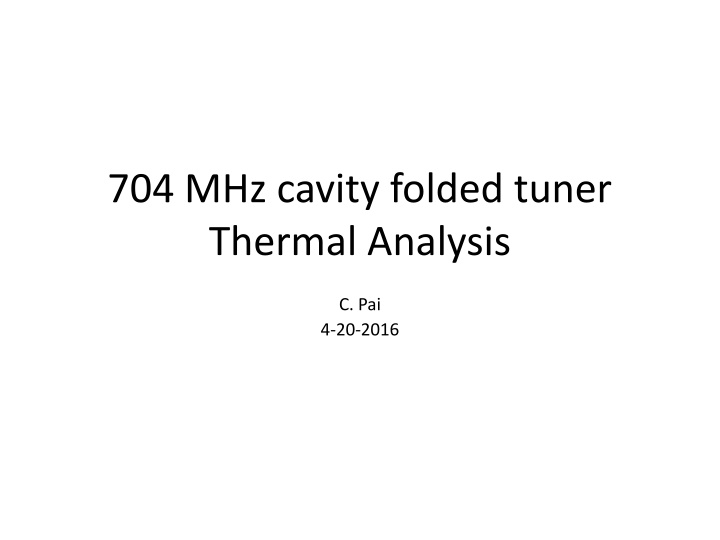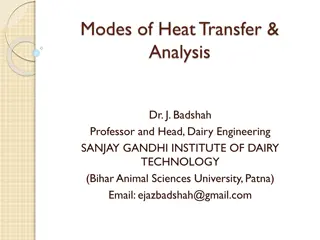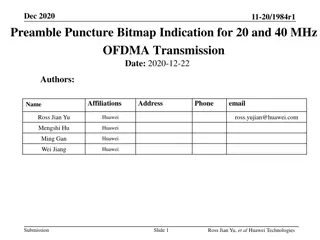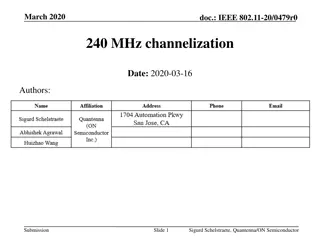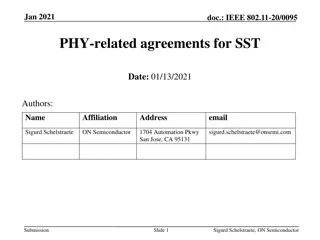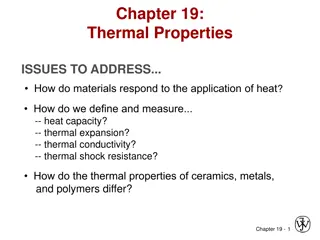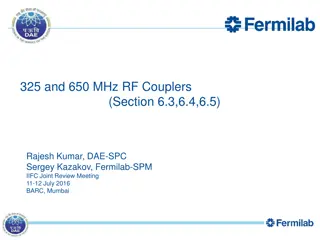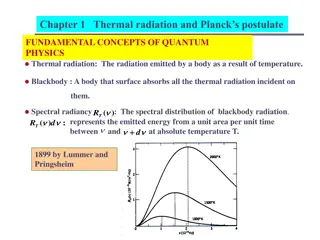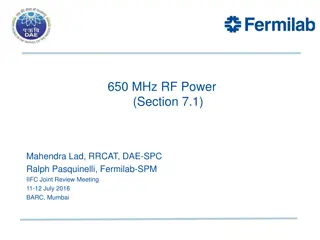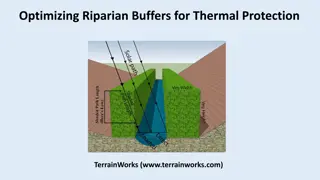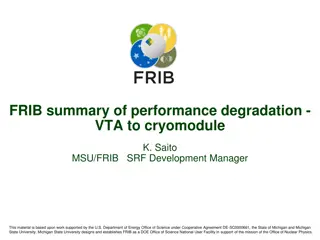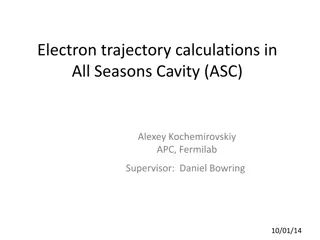704 MHz cavity folded tuner Thermal Analysis
This document discusses the thermal analysis results of a 704 MHz cavity folded tuner. The meeting minutes from April 20, 2016, provide insights into the design modifications and priorities related to the tuner assembly. Decision points on further thermal analysis and design adjustments are highlighted, along with action items for team members. The conceptual designs and potential extensions for the tuner port length are also addressed in the content.
Download Presentation

Please find below an Image/Link to download the presentation.
The content on the website is provided AS IS for your information and personal use only. It may not be sold, licensed, or shared on other websites without obtaining consent from the author.If you encounter any issues during the download, it is possible that the publisher has removed the file from their server.
You are allowed to download the files provided on this website for personal or commercial use, subject to the condition that they are used lawfully. All files are the property of their respective owners.
The content on the website is provided AS IS for your information and personal use only. It may not be sold, licensed, or shared on other websites without obtaining consent from the author.
E N D
Presentation Transcript
704 MHz cavity folded tuner Thermal Analysis C. Pai 4-20-2016
Meeting Minutes 4/20/2016 Zaltsman, Alexander <zaltsman@bnl.gov>; Pai, Chien-Ih <pai@bnl.gov>; Brennan, Joseph <brennan@bnl.gov>; Brutus, Jean Clifford <jcbrutus@bnl.gov>; Xiao, Binping <binping@bnl.gov>; Fedotov, Alexei <fedotov@bnl.gov>; Grau, Manuel <mgrau@bnl.gov> Results look very good, we can live with the localized higher temperature. Assumption of 50% thread was very conservative and may cause the higher temperature rise in the model. It was agreed that no further thermal analysis is needed unless there is some other change in the RF design or results. Cliff is going to look into modifying/manufacturing tuner from the cold model to be adaptable to the factory acceptance tests. Binping will run the simulations to see if the reduction of the gap indeed significantly reduces the power dissipated in the tuner. Do want to reduce the lateral gaps between the tuner elements from 3mm to 2 mm. This will allow the copper cup to be thicker which will reduce temperature, again unless something else changes, there is no need for further temperature analysis. Question for Mike and Binping: Will changing from 3 mm to 2 mm gaps require further RF analysis? Because of the reduced gap clearance, Cliff was requested to verify what the catalog accuracy of the Kurt Lesker drive means 2mm at 1 meter . Requested Cliff to develop a simplified geometric representation of the possible tracking error in the drive system and verify that 1 mm and 2 mm clearance is okay. Hold a short review meeting. Manny s next priority is to do an ECN on the 704 cavity to extend the tuner flange. Overall design priorities in order for Manny: 1. ECN for 704 tuner flange location 2. Complete 2.1 GHz tuner assembly fabrication drawings after they have been checked (drawings have been submitted for checking). 3. Complete 704 MHz tuner assembly model with Kurt Lesker vacuum drive assembly and adapter flange (hold a design review and approval). 4. Complete 704 MHz tuner assembly fabrication drawings and submit for checking. 5. Complete 2.1 GHz support and stand assembly. 6. Complete 2.1 GHz vacuum transitions, ion pump support, and installation drawings. By time item 5 is underway Sal Picataggio may be available to do items 5 and 6 for the 704 MHz cavity.
704 MHz Cavity with folded tuner, Based on 704M_v7_704MHzv2_chokeTuner.stp
704 MHz Tuner conceptual design Water shaft Cap Tube Cuff
Tuner port length may need extension 704 MHz tuner 1.94 2.1 GHz tuner 6
Tuner position -6 mm +12mm 0 mm
Integral model for FE analysis Assume 50% contact between both threads and contact interfaces Water flow rate 10 gpm T water : 35oC (avg. Inlet: 30oC, T Room : 35oC V of water: 2.3 m/s H coefficient: 13,000 W/m2C Outlet: 40oC) Convection surface
Electrical field plot (normalized) when tuner at +12 mm position Frequency: 704.863811 MHz Q-factor : 33066.5845 Surface loss=: 0.753075E-09 W
E field along beam line Gap voltage: EMF along beam line = 0.103469837 V (normalized) Scale factor based on V: 645.6KV/0.103469837 V =6.239x106
Magnetic field plot (normalized) when tuner at +12 mm position Frequency: 704.863811 MHz Q-factor : 33066.5845 Surface loss=: 0.753075E-09 W
Magnetic field plot (normalized) when tuner at +12 mm position Viewed with tuner port
Magnetic field plot (normalized) when tuner at +12 mm position Viewed from port corner
Heat Flux distribution on cavity surface loss (normalized RF calculation) Surface loss from normalized model=0.753075E-09 W Scale factor based on V: 645.6KV/0.103469837 V =6.239x106 Scale factor based on surface quality =1.3 Heat flux scaled up factor =(6.239x106)2x1.3 =5.061x1013 Total Scaled up Heat loss =38.1137 KW
Heat Flux distribution on cavity surface loss (normalized RF calculation) View from inside Total Scaled up Heat loss =38.1137 KW
Heat Flux distribution on tuner surface loss (normalized RF calculation) Surface loss=0.515045E-10 W Scale factor based on V: 645.6KV/0.103469837 V =6.239x106 Scale factor based on surface quality =1.3 Heat flux scaled up factor =(6.239x106)2x1.3 =5.061x1013 Total Scaled up Heat loss In tuner =2.6067 KW
Heat Flux distribution on tuner surface loss (normalized RF calculation) Surface loss=0.515045E-10 W Scale factor based on V: 645.6KV/0.103469837 V =6.239x106 Scale factor based on surface quality =1.3 Heat flux scaled up factor =(6.239x106)2x1.3 =5.061x1013 Total Scaled up Heat loss In tuner =2.6067 KW
Heat Flux distribution on cuff surface loss (normalized RF calculation) Surface loss=0.489222E-12 W Scale factor based on V: 645.6KV/0.103469837 V =6.239x106 Scale factor based on surface quality =1.3 Total Scaled up Heat loss In cuff = .02476 KW Heat flux scaled up factor =(6.239x106)2x1.3 =5.061x1013
Heat Flux distribution on cuff surface loss (normalized RF calculation) Surface loss=0.489222E-12 W Scale factor based on V: 645.6KV/0.103469837 V =6.239x106 Scale factor based on surface quality =1.3 Heat flux scaled up factor =(6.239x106)2x1.3 =5.061x1013 Total Scaled up Heat loss In cuff = .02476 KW
Temperature distribution of water cooled tuner Water flow rate 10 gpm T water : 35oC (avg) H: 13,000 W/m2C Total heat input: 2.6067 KW Max. T: 124.68oC tip of tuner skirt oC
Temperature distribution of tuner cap Max. T: 124.68oC At tip of tuner skirt oC
Temperature distribution of water shaft Max. T: 89.58oC At top of contact surface oC
Summaries: (Tuner at +12 mm) RF results: (normalized value) Frequency: 704.863811 MHz Q-factor = 33066.5845 Surface loss=0.753075E-09 W Gap voltage along beam line = 0.103469837 V (normalized) Scale factor from E field: 645.6KV/0.103469837V =6.239x106 Scale factor due to surface quality =1.3 Total Scaled up factor for heat loss (6.239x106)2x1.3 =5.061x1013 Total Heat Loss= 38.1137 KW 23
Summaries (cont.): Thermal Results: Total Scaled up Heat in whole cavity = 38.1137 KW Heat loss in body: Heat loss in tuner: Heat loss in cuff: .0247 KW 35.4823 KW 2.6067 KW Water flow rate in tuner: 10 gpm T water : 35oC (avg. of inlet: 30oC, outlet: 40oC) T Room : 35oC V of water: 2.3 m/s H coefficient: 13,000 W/m2C Max. T in the tuner : 124.68oC At tip of tuner skirt (cap) : 89.58oC At top of contact surface (water shaft) 24
